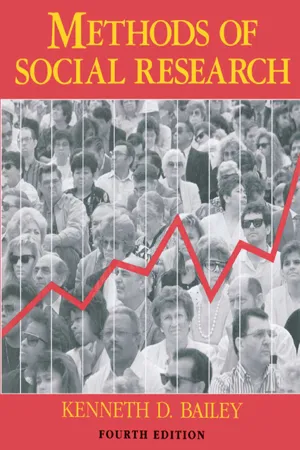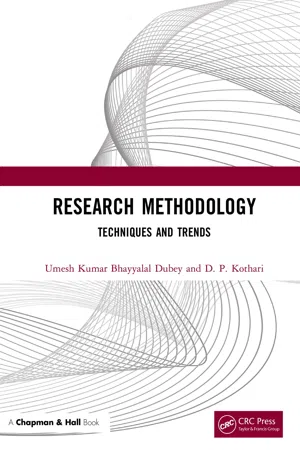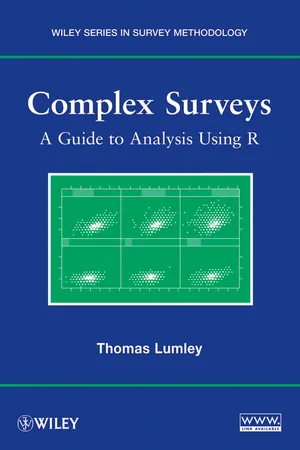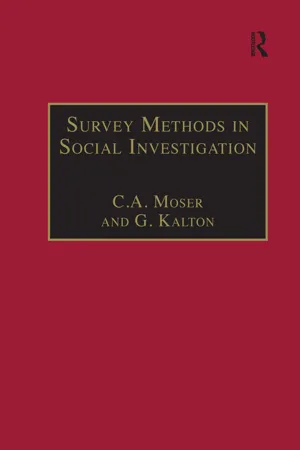Psychology
Stratified Sampling
Stratified sampling is a research method that involves dividing the population into subgroups, or strata, based on certain characteristics such as age, gender, or socioeconomic status. Researchers then randomly select participants from each stratum to ensure that the sample is representative of the entire population. This approach allows for more accurate and reliable results by accounting for diversity within the population.
Written by Perlego with AI-assistance
Related key terms
Related key terms
1 of 4
Related key terms
1 of 3
12 Key excerpts on "Stratified Sampling"
- eBook - ePub
Quantitative Techniques in Business, Management and Finance
A Case-Study Approach
- Umeshkumar Dubey, D P Kothari, G K Awari(Authors)
- 2016(Publication Date)
- Chapman and Hall/CRC(Publisher)
Merits of stratified random samplingThe size of the sample for the universe, that is the college, would be 75 (i.e. 5% of 1500, the total number of students in the college). Since the proportionate stratified method used is at 5%, the sample size of the nine different strata would be at 5% of their respective size, as shown in Table 8.7.Stratification means division into layers or groups. Stratified random sampling involves the following steps or subpopulation, called strata, such that- The units written for each stratum (subgroup) are as homogenous as possible.
- The differences between various strata are as marked as possible; that is, the stratum means differ as widely as possible.
- Various strata are non-overlapping. This means each and every unit in the population belongs to one and only one stratum.
Thus, in Stratified Sampling the given population of size N is divided into say k relatively homogeneous strata of sizes N1 , N2 , …, Nk , respectively, such thatN =Σi = 1kN i- Draw simple random samples (without replacement) from each of the k strata (i = 1, 2, 3, …, k) such that
where n is the total sample size from a population of size N. The sample ofΣi = 1kn i= n ,units is called a stratified random sample (without replacement). The technique of drawing such a sample is called stratified random sampling.Σi = 1kn i= n ,- More representatives. It provides more representative samples for a universe. Since the population is first divided into various strata and then the samples are drawn at random from each of the strata, it gives an adequate representation to each stratum or division of the population, and thereby overrules the possibility of any essential group of the population being left out completely. The sample itself is free.
- More beneficial. It overcomes the drawbacks of both purposeful and random sampling, and all the same, it enjoys the advantages of both methods by dividing a heterogeneous universe into a number of homogeneous strata with respect to purposeful characteristics and then uses the technique of random sampling in the drawing of samples from each stratum. This type of sampling balances the uncertainty of random sampling against the bias of deliberate selection.
- eBook - ePub
Dissertation Research Methods
A Step-by-Step Guide to Writing Up Your Research in the Social Sciences
- Philip Adu, D. Anthony Miles(Authors)
- 2023(Publication Date)
- Routledge(Publisher)
This is because every single individual in the sampling frame has a known and non-zero chance of being selected into the sample. For this reason, it is the ideal and recognized single stage random sampling. The advantage of this sampling is that it has moderate usage and moderate cost, internal and external validity is high, and it is simple to draw and easy to verify. The disadvantage is that, technically, only the selection of the first subject is a probability selection, since for subsequent selections there will be subjects with zero chance of selection (Scheaffer et al., 2006 ; Tabachnick & Fidell, 2013 ; Acharya et al., 2013 ; Singh & Masuku, 2013 ; Taherdoost, 2016 ; Rao, 2000 ; Martino et al., 2018). Stratified Sampling Stratified Sampling is most suitable when the population consists of heterogeneous subpopulation groups. Stratified Sampling is used when the population is divided into strata (or subgroups) and a random sample is taken from each subgroup. A subgroup is a natural set of items. Subgroups might be based on company size, gender or occupation (to name but a few). Stratified Sampling is often used where there is a great deal of variation within a population. In this type of sampling, the target population is first divided into separate strata. Then, samples are selected within each stratum, either through simple or systematic sampling. The total number of individuals to be selected in each stratum can be fixed or proportional to the size of each stratum. Each individual may be equally likely to be selected to participate in the study. However, the fixed method usually involves the use of sampling weights in the statistical analysis (inverse of the probability of selection or 1/P) - eBook - ePub
- Kenneth Bailey(Author)
- 2008(Publication Date)
- Free Press(Publisher)
k = 10) the first shopper can be chosen randomly from the first ten, and thereafter each tenth shopper can be interviewed. While the last shopper is being interviewed the first can be home in bed. But with random sampling (random order of appearance of shoppers not assumed) the researcher would have to detain all shoppers until he or she got a complete population, list them all on a sampling frame, number them all, then select randomly; only after all that can he or she begin interviewing. The ones who were not selected would not be free to go home until the entire sample was completed.Stratified Random Sampling
According to Mendenhall, Ott, and Scheaffer (1971, p. 53), a stratified sample is obtained by separating the population elements into nonoverlapping groups, called strata, and then selecting a simple random sample from within each stratum. Notice that although the word “strata” implies rank order (from higher to lower strata), the method of Stratified Sampling can be applied to any mutually exclusive (nonoverlapping) groups, regardless of whether or not they are rank-ordered. By mutually exclusive we simply mean that no sampling unit appears in more than one group.Consider Stratified Sampling of groups that are rank-ordered, such as full professors, associate professors, and assistant professors. Stratified Sampling consists of listing all full professors together in one homogeneous group, then all associate professors, then all assistants. After that is done, a random (or systematic) sample is drawn within each group. This procedure not only avoids the possible biases of taking a systematic sample from a nonStratified Sampling frame (with periodic cycles of ranks) but can also save time and money. Although a random sample drawn from a nonStratified Sampling frame should represent all ranks adequately, it might require a much larger sample than would a stratified sample, which ensures that each rank is represented. The potential saving of time and money in interviewing is even greater if the variable that is stratified (e.g., military or professional rank) is correlated with other variables (age, sex, income). A stratified sample will thus assure representation not only of all ranks but simultaneously of all age and income ranks within the population being sampled. - eBook - ePub
Sampling Essentials
Practical Guidelines for Making Sampling Choices
- Johnnie N. Daniel(Author)
- 2011(Publication Date)
- SAGE Publications, Inc(Publisher)
- Stratified samples yield smaller random sampling errors than those obtained with a simple random sample of the same sample size, especially if optimum allocation is used. Stratification makes for a gain in precision, eliminating the variation of the variable that is used for stratifying. The amount of gain in precision is determined by the extent the within-stratum variances of the study variables are minimized and the between-stratum variances of the study variables are maximized. Stratification will yield a sample that is at least as precise as a simple random sample of the same size. If it is ineffective in increasing the level of precision, the results would not be worse than if simple random sampling were used.
- Stratified samples tend to be more representative of a population because they ensure that elements from each stratum in the population are represented in the sample. Sampling may be stratified to ensure that the sample is spread over geographic subareas and population subgroups.
- In using Stratified Sampling, advantage is taken of knowledge the researcher has about the population.
- If the stratification variable breaks up the population into homogeneous geographical areas, data collection costs may be lower than the data collection costs of sample random sampling.
- Utilizing Stratified Sampling permits the researcher to use different sampling procedures within the different strata.
- In using Stratified Sampling, a researcher may be created taking into account administrative convenience in carrying out the study. The researcher may take into account the clustering of the population in metropolitan areas, institutionalized segments of the population, and the distribution of data collection staff.
Compared to simple random sampling, weaknesses of Stratified Sampling include:- Stratified Sampling has a greater requirement for prior auxiliary information than is the case for simple random sampling. Information on stratification variables is required for each element in the population. Such information includes information on the proportion of the target population that belongs to each stratum; if optimum allocation is used, information on the variability of the variables of interest and information on the data collection costs are necessary for each stratum. Acquiring such information may be time-consuming and costly.
- Selection of stratification variables may be difficult if a study involves a large number of variables. These variables should be correlated with the variables of interests in the study.
- eBook - ePub
Research Methodology
Techniques and Trends
- Umesh Kumar B Dubey, D P Kothari(Authors)
- 2022(Publication Date)
- Chapman and Hall/CRC(Publisher)
The groups or strata are created on the basis of a variable or criteria known to be correlated with the variable under study. The possible criteria for stratification of a population could be Income of the individuals, Age, Sex, Purchasing frequency, Household size, Retail store size, Region of the country, etc.Also, on the basis of more than one variable, the stratification is possible. This increases the number of stratum; the cost of stratification may come as a constraint in increasing the number of stratum or group.A variable that is considered to be good in stratification of one population may not be so in the case of other. However, one aspect that must be kept in mind is that stratification should be done in such a way as to minimize the variability among sampling unit within strata, i.e., more homogeneous and maximize the variability among strata, i.e., more heterogeneous.The Stratified Sampling method is used when the population is heterogeneous rather than homogeneous. The process of grouping members of the population into relatively homogeneous subgroups before sampling is called as stratification. It should be ensured that each element in the population is assigned a particular stratum only. The strata should also be collectively exhaustive to ensure that no population element is excluded.Separate simple random sample of various sizes is selected from each stratum, once the population has been divided into various strata. Then random sampling is applied within each stratum independently. This often improves the representativeness of the sample by reducing sampling error.A heterogeneous population is composed of unlike elements such as male or female, rural or urban, literate or illiterate, high-income or low-income groups, etc. In such cases, the use of simple random sampling may not always provide a representative sample of the population.There are two approaches to decide the sample size from each stratum, namely, proportional stratified sample and disproportional stratified sample. With either approach, the Stratified Sampling guarantees that every unit in the population has a chance of being selected. These two approaches of selecting samples are discussed below. - eBook - ePub
- Judy L. Krysik(Author)
- 2018(Publication Date)
- Routledge(Publisher)
Consider, for example, a large child welfare agency and a sampling frame that is ordered by operational unit. Each unit is listed with the unit supervisor first, followed by five caseworkers. In this instance, drawing a systematic random sample could either overrepresent or underrepresent the caseworkers and the unit supervisors. If the researcher chose an interval of 6, for example, he or she would end up selecting only the supervisors. Stratified Random Sampling Researchers should adopt the method of stratified random sampling when they have reason to believe that the outcome of interest varies among the different subgroups in the population, and those subgroups run the risk of being overlooked or underrepresented in simple or systematic random sampling. For example, when researchers from the Gallup Organization examine health habits among seniors, they know that the results may vary by those who use landline phones and those who use cell phones. For this reason, they make certain their samples include representatives from both subgroups. Using this method can reduce error by helping to ensure that the sample is more representative of the population than it might have been with simple or systematic random sampling. The process of stratified random sampling is spelled out in Advanced Skill Development 8.1. To draw a sample, the researcher first divides the sampling frame into two or more strata to be sampled independently. The strata are categories of variables determined to be important on the basis of prior knowledge. For example, in a study of literacy in childhood, the parents’ primary language is an important variable. The researcher in this case may decide to create three strata: children whose parents speak only English, children whose parents speak only one non-English language such as monolingual Spanish speakers, and children with parents who are bilingual. Sometimes the researcher may stratify the sample on more than one variable - No longer available |Learn more
Analyzing Media Messages
Using Quantitative Content Analysis in Research
- Daniel Riffe, Stephen Lacy, Brendan R. Watson(Authors)
- 2019(Publication Date)
- Routledge(Publisher)
Stratified random selection would be better because the language likely changed with time. Support for the war was much stronger in 1966 than in 1974. A simple random sample could generate a sample with most of the speeches either at the beginning or end of this period. Using years as strata, however, makes smaller homogeneous groups that would guarantee a more representative sample. The percentage of total speeches that were made in each year would determine the percentage of the sample to come from that year. Stratified Sampling serves two purposes. First, it increases the representativeness of a sample by using knowledge about the distribution of units to avoid the oversampling and undersampling that can occur from simple random sampling. This is proportionate sampling, which selects sample sizes from within strata based on the stratum’s proportion of the population. A study of Facebook or Twitter postings might stratify by topic areas. The percentage of sample messages from a given topic area would represent that topic area’s proportion of the entire population. If 20% of all messages address the topic “movies,” then 20% of the sample should come from posts about movies. This will make the sample more representative of the entire posting activity. In some situations, stratifying can increase the number of units in a study when those types of units make up a small proportion of the population. This is disproportionate sampling, which involves selecting a sample from a stratum that is larger than that stratum’s proportion of the population. This procedure allows a large enough sample for comparison. If, for instance, in a study, only 10% of 1,000 Twitter account owners are older than 60, and the study concerns the relationship between age and tweets, the researcher might want to disproportionately sample from the stratum of participants older than 60. With 10% 60 or older, a simple random sample of 200 would probably likely yield only 20 people in this category - eBook - ePub
Statistics in Engineering
With Examples in MATLAB® and R, Second Edition
- Andrew Metcalfe, David Green, Tony Greenfield, Mayhayaudin Mansor, Andrew Smith, Jonathan Tuke(Authors)
- 2019(Publication Date)
- Chapman and Hall/CRC(Publisher)
14.3 Stratified SamplingThe sample size of 31 is higher than the company is prepared to take. With a coefficient of variation of 0.5, the sample size would be 13. The company decides to take an initial sample of 10, and will review the situation when it has a better estimate of the population standard deviation based on the 10 sampled water towers.A population can often be considered as a union of disjoint sub-populations, as in the U.S. and its states. Information may be needed for sub-populations. Also, if sub-populations are relatively homogeneous, compared to the whole, we can improve the precision of estimators for a given sample size.Definition 14.7: Stratum14.3.1 Principle of Stratified SamplingA population is stratified if it is divided into sub-populations according to criteria that are known for all elements in the population. Each sub-population is a stratum.The population is divided into sub-populations called strata, and samples are taken from each stratum. The division into strata can be based on any criteria that take account of known characteristics of elements of the population or on subjective assessment, but to be efficient the items within a stratum need to be relatively similar, in terms of the variable of interest, when compared with items from different strata. Totals can be estimated for each stratum as well as for the population as a whole.14.3.2 Estimating the population mean and totalSuppose we have a population of N sampling units divided into H strata. The strata have sizes of Nh h = 1,…, H sampling units. The value of the variable for the ith unit in stratum h is denoted byThe stratum totals, and hence the population total, areyfor i = 1 , … ,h iN hand h = 1 , … , H .It follows that the stratum means, and population mean, areT=U , hand∑i = 1N hyh iT U=∑h = 1HTU, h ,The stratum variances are defined as=y ¯U , handTU , hN h=y ¯U.T UNs=U , h2.∑i = 1N h(2)y−h iy ¯U , hN h− 1Now suppose we take SRS of size nh - eBook - ePub
Researching Health Needs
A Community-Based Approach
- Judy Payne(Author)
- 1999(Publication Date)
- SAGE Publications Ltd(Publisher)
stratified sample.To select a stratified sample, you must first decide which characteristics might influence your study and whether you can identify everyone on your list according to these. For example, you might decide that age was an important distinguishing characteristic. If your list was an electoral roll, you would only be able to divide it into those aged over 17 but under 18 and those over 18. Clearly, this would not be suitable in most cases. However, if you were using a GP’s age/sex register, you would be able to group (or ‘stratify’) your population into whatever age bands you wished. Each group or ‘strata’ would then become a separate list. You would then be ready to draw a sub-sample from each list using the same sampling fraction (say, one in ten or one in three) by employing any of the simple random sampling methods discussed above. When all lists have been sampled, your overall sample would have the same proportion of each group as that of the total population. This is termed proportional sampling. For instance, in a study of the health needs of older people, you may decide that those aged 75 years and over are likely to have different needs than the younger group. Your population list consists of 610 people in the 60–74 age group and 390 people in the 75 and over age group (or 61 per cent and 39 per cent, respectively). If you draw a one in five sample from each list, you will obtain 122 from the 60–74 age group and 78 from the 75 and over age group, giving 122/200 (61 per cent) and 78/200 (39 per cent): the same proportions as in your population.It is also possible to draw a stratified sample disproportionate. In populations that include only a small number of people with a particular characteristic, a proportionally drawn sample like the one above might not give enough cases of those with the characteristic from which to derive any meaningful findings. In this case, to achieve an acceptable number of the small group in your sample, a larger number would be selected from this group than from the rest, and the sample would be disproportional - eBook - ePub
- Gary T. Henry(Author)
- 1990(Publication Date)
- SAGE Publications, Inc(Publisher)
One caution is necessary in using systematic sampling. The sampling frame must be well mixed or purposefully arranged for stratification. If a cyclical arrangement of the frame is inadvertently used, the sample can be biased. For example, if the frame is a listing of monthly sales and six (6) is selected for the interval, only sales from 2 of the 12 months, say, March and September, would be included. Seasonal patterns would be ignored in the data and the results would be biased. This can be avoided by reducing the sampling interval to five in this case and removing additional cases as above.If on-site fieldwork is required, a disadvantage of this technique is the dispersal of the fieldwork across the entire geographic spread of the study population. Costs of travel and supporting the fieldwork may be prohibitive. Formulas to compute standard errors for simple random samples can be used for systematic samples.Stratified SamplingStratified Sampling involves grouping the study population into strata and selecting a random sample within each stratum. Stratified Sampling is often used to ensure proportional representation for each stratum, decrease the sampling variability, or to yield a sufficient number of a subpopulation in the sample for reliable analysis.Stratified Sampling can be done proportionately or disproportionately. The former ensures proportionate representation of the strata by using the same sampling fraction in each stratum. Table 6.1 shows an example of a proportionally stratified sample. In the example, the level of mother’s education is used to divide the students into three strata. This variable is known to be an important predictor of cognitive skills and, therefore, it is important proportionally to represent three groups: less than high school education, high school degree but no college degree, college degree.TABLE 6.1Proportionate Stratified Sample for Test Scores Stratified by Mother’s Education LevelProportional stratification. Because each stratum has different numbers of members, the samples for each stratum are different sizes when using proportional stratification, as shown in Table 6.1 - eBook - ePub
Complex Surveys
A Guide to Analysis Using R
- Thomas Lumley(Author)
- 2011(Publication Date)
- Wiley(Publisher)
In this case they will create a table of estimated population proportions or estimated population counts for each category of the factor. For example, svytotal(˜stype, srs_design) estimates the total number of elementary schools, middle schools, and high schools in California. Multiple variables can be analyzed in the same call to svytotal() or svymean(), and contrasts can be computed from the results. Figure 2.4 computes the mean of the Academic Perfomance Index for the years 1999 and 2000. The call to svycontrast() computes the difference between the 1999 and 2000 means: (1 × 2000 mean) + (–1 × 1999 mean). An alternative notation is svycontrast(means, quote(api00-api99)) where quote() is used to quote an arithmetic expression. The calls to update() create additional variables in the survey design object. Note that these calls return a new survey design object that must be given a name. In this case it is assigned the same name as the original object. 2.2 Stratified Sampling Simple random samples are not used very often in large surveys, because other designs can give the same precision at lower cost. One way to increase precision is Stratified Sampling, which involves dividing the population up into groups called strata and drawing a separate probability sample from each one. Stratification ensures that a prespecified number of observations from each stratum end up in the sample, rather than allowing distribution of observations across strata to be random. The sample is less variable, and so gives more precise estimates. The primary limitation to Stratified Sampling is that, in order to sample within a stratum, the stratum membership must be known for every individual in the population. It is worth noting that the term “stratification” is used in epidemiology for an entirely different process where a sample is analyzed separately in groups based on the values of a variable observed on the sample - eBook - ePub
- C.A. Moser, G. Kalton(Authors)
- 2017(Publication Date)
- Routledge(Publisher)
Before going further, it may be useful to emphasize the respective roles of stratification and of spreading a sample over several stages. Although these two features of design fulfil quite different functions, the newcomer to the subject often has difficulty in distinguishing them. Continuing with our illustration, suppose that there are suitable lists of districts and of individuals within districts from which the sample of 2,000 adult civilians can be drawn. Let us look at four possibilities:Design I. Simple random sample
This would involve taking the list of adults for the entire country and extracting from it a sample of the required size, either by random numbers or by some systematic procedure.1Design II. Unstratified, two-stage sample
Sample I would be too thinly spread over the country to be practicable. We may decide instead to concentrate the sample in a certain number of administrative districts, selecting, say, 100 such districts from a complete list of districts. We then turn to the list of individuals for each of the selected districts, and from it select the required number (20 on average).Design III. Stratified simple random sample
Either because the regions are believed to differ markedly from each other with regard to the subject of the survey or purely for convenience, we may decide to stratify by region (say, with a uniform sampling fraction). The first step is to allocate to each region its appropriate number of interviews. If South-West England has 7 per cent of the adult civilian population of Great Britain, 140 out of the sample of 2,000 individuals would be selected from this region. Up to this point no sampling has taken place. Stratification is merely a way of dividing the population into a number of sub-populations and allocating the sample between these sub-populations. Once this is done the sampling begins, and with simple random sampling within strata we would select the number of individuals required in a region from the entire list for that region.Design IV. Stratified, two-stage sample
The stratification by region is as in Design III. But in order to concentrate the interviewing, we select a sample of administrative districts in each region and then a sample of individuals from each of the selected districts.
Index pages curate the most relevant extracts from our library of academic textbooks. They’ve been created using an in-house natural language model (NLM), each adding context and meaning to key research topics.
Explore more topic indexes
Explore more topic indexes
1 of 6
Explore more topic indexes
1 of 4











